Paper Patch/Blackpowder Bullets
Grease Grooves - * - Base Guards - * - Production Knurling - * - Big Slugs
Power Press - * - Diamond Knurl - * - Nose Shapes
Base Shapes - * - Patch Formula - * - Single Die - * - Reloading Press

|
|
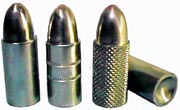 Paper patched or lubricated lead bullets can be swaged in two basic styles, the SWC shoulder style shown here, and the smooth ogive style shown below. The SWC style can be done in a single die, and therefore costs less for equipment and in time of production. The smooth ogive style is generally made in two steps, in two different kinds of dies. The first die has a cylindrical cavity, and can be the LSWC-1 or the CSW-1, both of which are functionally identical except the LSWC-1 generally has a nose and base punch that can form a SWC bullet, whereas the CSW-1 normally has just flat punches for making the lead slug or core. The second die has a cavity shaped like the bullet, and uses an internal punch only to push the bullet back out by its tip. The second die is called a PF-1 or point form die.
Paper patched or lubricated lead bullets can be swaged in two basic styles, the SWC shoulder style shown here, and the smooth ogive style shown below. The SWC style can be done in a single die, and therefore costs less for equipment and in time of production. The smooth ogive style is generally made in two steps, in two different kinds of dies. The first die has a cylindrical cavity, and can be the LSWC-1 or the CSW-1, both of which are functionally identical except the LSWC-1 generally has a nose and base punch that can form a SWC bullet, whereas the CSW-1 normally has just flat punches for making the lead slug or core. The second die has a cavity shaped like the bullet, and uses an internal punch only to push the bullet back out by its tip. The second die is called a PF-1 or point form die.
|
|
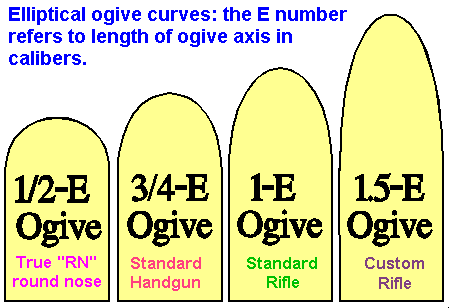
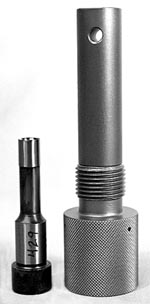 LSWC-1 Dies
LSWC-1 Dies
The LSWC-1-H is shown at the left (with external and internal punch). There is no major disadvantage to the shouldered or SWC style of bullet for short to medium range (100-300 yards). Many people prefer it to the smooth ogive type of bullet because the shoulder helps hold the paper patch from sliding back, if you overlap the edge slightly and use your thumbnail to crimp the edge of the paper over the shoulder.
The shoulder width is typically in the range of .015 to .020 inches. It is made necessary by the edge of the punch which forms the nose, in the LSWC-1 die. Making this edge thinner results in the punch wall becoming too weak to withstand the stress of moving the punch while under 30,000 psi or more pressure, so the edge of the punch simply breaks off or the punch cracks lengthwise. Making the punch edge at least .015 to .020 inches wide eliminates the problem. Very long range matches are best shot with the smooth ogive bullet, because this kind of bullet has slightly less drag and shoots somewhat flatter at long range.
 Another beneficial feature you can add to your lead bullet is the Base Guard(tm) disk. This copper disk scrapes fouling out with each shot, unlike the old-fashioned gas check, which simply irons over any fouling left in the bore. Base Guard disks attach to the base of the bullet when you form the bullet, all in one stroke. The disk has a small hole in the center. You use a BG base punch, which has a matching but larger round depression, and the lead flows through the hole in the disk and makes a rivet head in the punch depression.
Another beneficial feature you can add to your lead bullet is the Base Guard(tm) disk. This copper disk scrapes fouling out with each shot, unlike the old-fashioned gas check, which simply irons over any fouling left in the bore. Base Guard disks attach to the base of the bullet when you form the bullet, all in one stroke. The disk has a small hole in the center. You use a BG base punch, which has a matching but larger round depression, and the lead flows through the hole in the disk and makes a rivet head in the punch depression.
Now the Base Guard disk can turn, under pressure, on the axel created, so it tracks the rifling and maintains a good gas seal even if the bullet wants to skid or slip across the rifling. The BG disk is created with a conical shape, which flattens and allows the disk to grow when you swage the bullet. This insures that the disk comes exactly to the die walls, the same diameter as the bullet, for a zero tolerance perfect match. (A flat washer would vary slightly in diamter depending on manufacturing tolerances, which is why the old zinc based washer bullets had hit and miss success, depending on the exact size of the washer...even .001 inch difference is too much at 30,000 psi or higher, and gas would leak around them to melt the lead.) Unfortunately, BG's are not always allowed in certain kinds of matches, so check the rules.
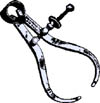 For hunting, and in matches where they are allowed, they help clean the bore of fouling with each shot fired. Some people even use them as fouling remover bullets in matches where they are not permitted for target scoring purposes. BG bullets do not require lubrication, in most cases. Even dead soft lead .44 Magnum bullets at full loads have been used without a bit of lubricant, with bores just about as clean after a match as they were before (using smokeless powder). With blackpowder, the disks work very well as long as the bore was clean when starting, and of course the last bullet fired still is followed by a charge of fouling, so all it can clean is the fouling from the previous shots, not the last one.
For hunting, and in matches where they are allowed, they help clean the bore of fouling with each shot fired. Some people even use them as fouling remover bullets in matches where they are not permitted for target scoring purposes. BG bullets do not require lubrication, in most cases. Even dead soft lead .44 Magnum bullets at full loads have been used without a bit of lubricant, with bores just about as clean after a match as they were before (using smokeless powder). With blackpowder, the disks work very well as long as the bore was clean when starting, and of course the last bullet fired still is followed by a charge of fouling, so all it can clean is the fouling from the previous shots, not the last one.
 BG disks are available from Corbin in bags of 1000, at considerably less than three cents each. Or you can make them using various models of Corbin BGK-1 base guard maker kits. Knurling should NOT be used with a BG bullet, as it might damage the gas seal on the disk edge. Grooves and lube are OK, but might not be necessary...save time by trying the disks by themselves, first, and only lube if you still have too much fouling. About 8 out of 10 guns work perfectly with soft lead and no lubricant, if the bullet is the right diameter to seal the bore. Some guns have either rougher bores, or the barrel has loose and tight places where gas gets around the seal...these may not work well with a BG disk. The odds are good, and the benefit is so high, that it is worth investigating.
BG disks are available from Corbin in bags of 1000, at considerably less than three cents each. Or you can make them using various models of Corbin BGK-1 base guard maker kits. Knurling should NOT be used with a BG bullet, as it might damage the gas seal on the disk edge. Grooves and lube are OK, but might not be necessary...save time by trying the disks by themselves, first, and only lube if you still have too much fouling. About 8 out of 10 guns work perfectly with soft lead and no lubricant, if the bullet is the right diameter to seal the bore. Some guns have either rougher bores, or the barrel has loose and tight places where gas gets around the seal...these may not work well with a BG disk. The odds are good, and the benefit is so high, that it is worth investigating.
|
|
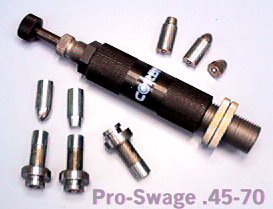 Pro-Swage Dies
Pro-Swage Dies
SWC style bulles can be made in your reloading press with the Pro-Swage(tm) adjustable weight die, in calibers from about 35 to 54. This kind of die uses a punch to form the nose, and you can change the nose simply by ordering different punch shapes. The base is formed with the other punch (there is always an internal and an external punch with swaging dies), so you can change it to suit your needs. In most cases a standard cup base is best. Flat, dished, hollow, heel and other styles can also be made with optional punches. Standard shapes of bases are shown below....
|
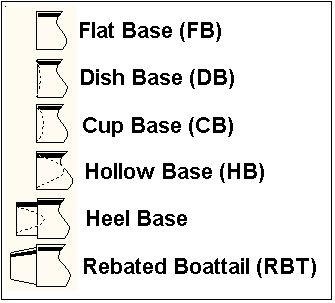
Paper-patched bullet design software is available from Corbin, as well as software that calculates multiple density, multi-part bullet weights and volumes, calculates bullet air resistance and BC, and helps you determine the bullet diameter for a given rifling depth and paper thickness. But a good rule of thumb is this:
- Determine the bore size of your gun, and rifling depth. The manufacturer or barrel maker can tell you. Call the bore size B and the rifling depth D.
- Measure the thickness of paper patch that you plan to use. Call this thickness T.
- The diameter of bullet you want to make for a muzzle loader then equals B-(4*T) with a tolerance of +.0015, -.0000. The diameter of bullet you want to make for a breech-loading cartridge gun is B+(2*D)-(4*T) with a tolerance of +.001, -.000.
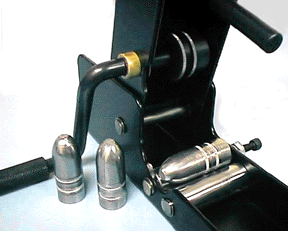 Rolling Grease Grooves
Rolling Grease Grooves
Since a solid swage die doesn't apply grooves to the sides of a bullet (or else the bullet would be locked into the die), grease grooves are rolled onto the bullet with the Corbin HCT-3 grooving tool. Another way to lubricate a lead bullet is to use the HCT-2 knurling tool. This method applies a pattern of diamond points pushed into the bullet, covering its shank entirely. The diamond points hold lube just like a waffle holds syrup, and provides more lube in contact with the bore than grooves do.
With the diamond-knurled bullet and smokeless powder, the more shallow depth of the lube works very nicely and helps prevent lube-induced imbalances when the bullet exits the barrel. But with black powder, the amount of lube held in the diamond pattern, and the kind of lube (usually a dry wax type) best used with the knurl, doesn't soften the fouling sufficiently. A grease wad following the bullet does the trick. The usual method in a cartridge type gun is to load the powder, push down a hard or "nitro" wad made of cardboard, then push down a greased felt wad, and finally seat the bullet. This process works on straight cases, but with bottle-necked cartridges like the 30-30 Winchester, the hard wad may drop below the neck of the case, and fail to keep the grease wad from contaminating the powder.
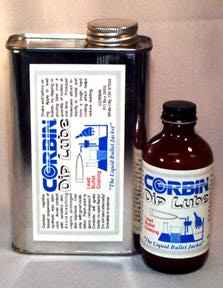 A more precise way to provide lubricated lead bullets is to use two dies, with a difference of at least .005 inches between the two bores. First swage the lead bullet in the smaller die (say, .452 diameter, which then lets you use that die for making .45 pistol bullets as a side benefit). The undersized rifle bullet is now knurled or grooved (using HCT-2, HCT-3, or the PCM-2 power cannelure machine explained below). Then, the bullet is dipped in lubricant and allowed to dry, or sprayed with a dry coating. Or a conventional wax/grease lube is applied.
A more precise way to provide lubricated lead bullets is to use two dies, with a difference of at least .005 inches between the two bores. First swage the lead bullet in the smaller die (say, .452 diameter, which then lets you use that die for making .45 pistol bullets as a side benefit). The undersized rifle bullet is now knurled or grooved (using HCT-2, HCT-3, or the PCM-2 power cannelure machine explained below). Then, the bullet is dipped in lubricant and allowed to dry, or sprayed with a dry coating. Or a conventional wax/grease lube is applied.
Finally, the bullet is swaged slightly larger in the final die, such as a .458 in this example. The bullet shortens slightly and becomes larger by the same volume of lead, trapping the lubricant and compressing it under tons of force, so it drives itself into the most minute fissures in the surface of the lead and becomes a perfect match without voids or pockets. Any air voids in the lube are squeezed out by the collapse of the lead into the space as the bullet shortens and expands. The result: nearly perfect lubricated lead bullets in two press strokes!
|
|
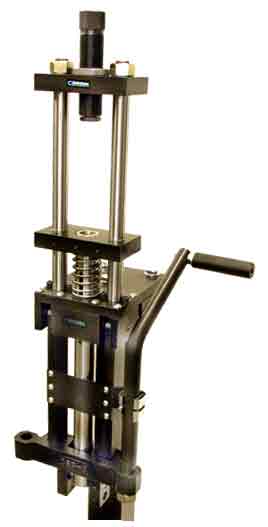 CSP-2 Mega-Mite Press
CSP-2 Mega-Mite Press
The Corbin Mega-Mite press provides a high precision press with Torrington needle bearing links and a hardened and ground alloy steel ram for both reloading (in the 6 inch stroke setting) and swaging (in the 3-inch stroke setting). The press head is threaded for 1-1/2 by 12 thread per inch, and the ram is threaded for 1-inch by 12 tpi. The Mega-Mite is especially useful for large bore calibers from .458 to .998 inch, for bullets in the 1.3 to 2.5-inch length range, and for lead hardness of Bhn 12 and up. (It will also make smaller, shorter bullets and softer lead bullets, but so will the CSP-1 press, which costs less and uses the type -S dies). The Mega-Mite uses type -H dies, same as the Hydro-Press and Hydro Junior.
The press comes with a ram extension/adapter with 7/8-14 threads, and a conventional RCBS T-slot adapter for your other calibers. An optional screw-in 50 BMG shell holder can be added, which fits directly into the adapter. Or, get the optional primer tool which comes with the shell holder, and can be used in the same setting both to knock out the old primer and to install the new one.
The Mega-Mite press (CSP-2) can be mounted directly to your bench top, or you can get it with the optional self-supporting floor stand (no need to mount the stand, as your own body weight standing on the attached deck holds it in place while operating the press). When purchased with the press, a discount applies to the stand.
|
|
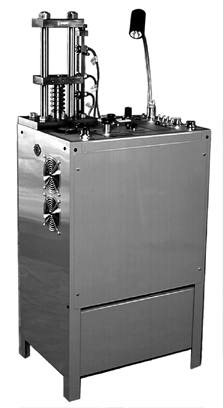 CHP-1 Hydro-Press
CHP-1 Hydro-Press
The Corbin Hydro-Press(tm) is the world's most popular and powerful bullet swaging and reloading press for custom bullet makers. It builds bullets as large as 1-inch diameter with ease. The reason to consider the CHP-1 instead of the Hydro Junior is the additional control and future expansion interfaces built into this top of the line model.
The CHP-1 uses electronic position sensing for the top of stroke, bottom of stroke, and an intermediate loading position. It can be set to automatically run a complete cycle and then wait for you to pick up the finished bullet and insert more components, with pressure and dwell time controlled by the press. Three pressure transducers, three non-contact electronic position transducers, and top panel precision timing (with dwell time in milliseconds and seconds) give you more control over critical stages in the operation.
The press provides built-in interfaces for operation and control of conveyer belts, jacket strip uncoiling machines, and other accessories that you may want in the future for making your own drawn jackets. It can be equipped with the JMK-2-H semi-automatic strip jacket drawing system, which feeds up to 150 pound pancake coils of jacket material into the press, automatically lubricating the strip, cutting a disk from it, and drawing the disk into a cup without operator intervention. A conveyer carries the cup into a bin for storage until it is processed further, while the scrap "web" of strip is cut into pieces and dropped into a recycle bin. The interfaces for these operations are not present in the lower priced Hydro Junior. A key lock switch prevents unauthorized persons from running the Hydro-Press, which can be locked in manual mode to prevent changeover to automatic operation.
|
|
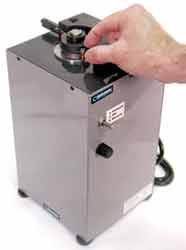 PCM-2 Power Cannelure Tool
PCM-2 Power Cannelure Tool
Grease grooves or knurling can be rolled on lead bullets by using the PCM-2 power cannelure machine. The PCM-2 can handle up to 100 bullets per minute, applying precision grooves at the exact position and depth you choose. Surface diamond pattern knurling can be used to hold far more lubricant in contact with the bore than would be possible with two or three grease grooves.
With other optional components, the PCM-2 can handle calibers from 224 to 1-inch Gatling. It operates on 115 or 240 v 50/60 HZ and forced air cooled for continuous operation.
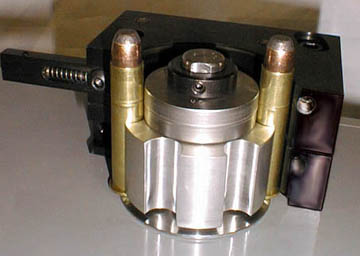 With optional cartridge feeding accessories, the PCM-2 can also roll precise cannelures on cartridge cases, so that the bullet won't push back into the case during feeding in auto-loaders. These custom built PCM-2 adaptations have been successfully applied to cartriges as diverse as 9mm and 45-70 WCF.
With optional cartridge feeding accessories, the PCM-2 can also roll precise cannelures on cartridge cases, so that the bullet won't push back into the case during feeding in auto-loaders. These custom built PCM-2 adaptations have been successfully applied to cartriges as diverse as 9mm and 45-70 WCF.
The PCM-2 comes with a hardened cannelure wheel with standard .050-wide knurled pattern, but custom wheels to roll any shape or style of groove can be ordered, including multiple grooves, crimping grooves with one sloped side and one right-angle side, radiused grooves, and different depths of grooves. The depth and position are precisely adjustable. With proper cannelure wheels, the PCM-2 can handle from 224 to 1-inch projectiles (224 to 458 is covered by standard size wheels; larger calibers also require a special backing plate).
|



 LSWC-1 Dies
LSWC-1 Dies Another beneficial feature you can add to your lead bullet is the Base Guard(tm) disk. This copper disk scrapes fouling out with each shot, unlike the old-fashioned gas check, which simply irons over any fouling left in the bore. Base Guard disks attach to the base of the bullet when you form the bullet, all in one stroke. The disk has a small hole in the center. You use a BG base punch, which has a matching but larger round depression, and the lead flows through the hole in the disk and makes a rivet head in the punch depression.
Another beneficial feature you can add to your lead bullet is the Base Guard(tm) disk. This copper disk scrapes fouling out with each shot, unlike the old-fashioned gas check, which simply irons over any fouling left in the bore. Base Guard disks attach to the base of the bullet when you form the bullet, all in one stroke. The disk has a small hole in the center. You use a BG base punch, which has a matching but larger round depression, and the lead flows through the hole in the disk and makes a rivet head in the punch depression.
 For hunting, and in matches where they are allowed, they help clean the bore of fouling with each shot fired. Some people even use them as fouling remover bullets in matches where they are not permitted for target scoring purposes. BG bullets do not require lubrication, in most cases. Even dead soft lead .44 Magnum bullets at full loads have been used without a bit of lubricant, with bores just about as clean after a match as they were before (using smokeless powder). With blackpowder, the disks work very well as long as the bore was clean when starting, and of course the last bullet fired still is followed by a charge of fouling, so all it can clean is the fouling from the previous shots, not the last one.
For hunting, and in matches where they are allowed, they help clean the bore of fouling with each shot fired. Some people even use them as fouling remover bullets in matches where they are not permitted for target scoring purposes. BG bullets do not require lubrication, in most cases. Even dead soft lead .44 Magnum bullets at full loads have been used without a bit of lubricant, with bores just about as clean after a match as they were before (using smokeless powder). With blackpowder, the disks work very well as long as the bore was clean when starting, and of course the last bullet fired still is followed by a charge of fouling, so all it can clean is the fouling from the previous shots, not the last one.
 BG disks are available from Corbin in bags of 1000, at considerably less than three cents each. Or you can make them using various models of Corbin BGK-1 base guard maker kits. Knurling should NOT be used with a BG bullet, as it might damage the gas seal on the disk edge. Grooves and lube are OK, but might not be necessary...save time by trying the disks by themselves, first, and only lube if you still have too much fouling. About 8 out of 10 guns work perfectly with soft lead and no lubricant, if the bullet is the right diameter to seal the bore. Some guns have either rougher bores, or the barrel has loose and tight places where gas gets around the seal...these may not work well with a BG disk. The odds are good, and the benefit is so high, that it is worth investigating.
BG disks are available from Corbin in bags of 1000, at considerably less than three cents each. Or you can make them using various models of Corbin BGK-1 base guard maker kits. Knurling should NOT be used with a BG bullet, as it might damage the gas seal on the disk edge. Grooves and lube are OK, but might not be necessary...save time by trying the disks by themselves, first, and only lube if you still have too much fouling. About 8 out of 10 guns work perfectly with soft lead and no lubricant, if the bullet is the right diameter to seal the bore. Some guns have either rougher bores, or the barrel has loose and tight places where gas gets around the seal...these may not work well with a BG disk. The odds are good, and the benefit is so high, that it is worth investigating.
